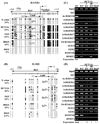DNMT1 and DNMT3B modulate distinct polycomb-mediated histone modifications in colon cancer
- PMID: 19723660
- PMCID: PMC2745494
- DOI: 10.1158/0008-5472.CAN-09-0116
DNMT1 and DNMT3B modulate distinct polycomb-mediated histone modifications in colon cancer
Abstract
DNA methylation patterns are established and maintained by three DNA methyltransferases (DNMT): DNMT1, DNMT3A, and DNMT3B. Although essential for development, methylation patterns are frequently disrupted in cancer and contribute directly to carcinogenesis. Recent studies linking polycomb group repression complexes (PRC1 and PRC2) to the DNMTs have begun to shed light on how methylation is targeted. We identified previously a panel of genes regulated by DNMT3B. Here, we compare these with known polycomb group targets to show that approximately 47% of DNMT3B regulated genes are also bound by PRC1 or PRC2. We chose 44 genes coregulated by DNMT3B and PRC1/PRC2 to test whether these criteria would accurately identify novel targets of epigenetic silencing in colon cancer. Using reverse transcription-PCR, bisulfite genomic sequencing, and pyrosequencing, we show that the majority of these genes are frequently silenced in colorectal cancer cell lines and primary tumors. Some of these, including HAND1, HMX2, and SIX3, repressed cell growth. Finally, we analyzed the histone code, DNMT1, DNMT3B, and PRC2 binding by chromatin immunoprecipitation at epigenetically silenced genes to reveal a novel link between DNMT3B and the mark mediated by PRC1. Taken together, these studies suggest that patterns of epigenetic modifiers and the histone code influence the propensity of a gene to become hypermethylated in cancer and that DNMT3B plays an important role in regulating PRC1 function.
Figures






References
-
- Goll MG, Bestor TH. Eukaryotic cytosine methyltransferases. Annu Rev Biochem. 2005;74:481–514. - PubMed
-
- Leonhardt H, Page AW, Weier H, Bestor TH. A targeting sequence directs DNA methyltransferase to sites of DNA replication in mammalian nuclei. Cell. 1992;71:865–873. - PubMed
-
- Okano M, Bell DW, Haber DA, Li E. DNA methyltransferases Dnmt3a and Dnmt3b are essential for de novo methylation and mammalian development. Cell. 1999;99:247–257. - PubMed
-
- Xu G-L, Bestor TH, Bourc'his D, et al. Chromosome instability and immunodeficiency syndrome caused by mutations in a DNA methyltransferase gene. Nature. 1999;402:187–191. - PubMed
Publication types
MeSH terms
Substances
Grants and funding
LinkOut - more resources
Full Text Sources
Other Literature Sources

